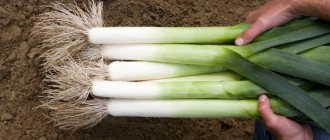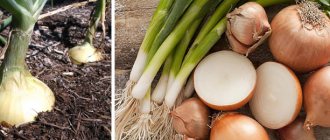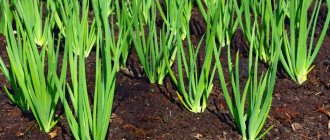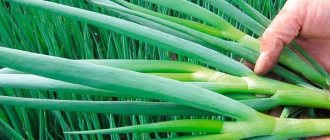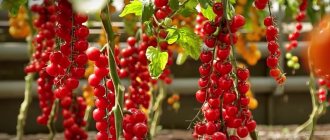Secrets of growing leeks in open ground from seeds and seedlings.
Just a couple of years ago, leeks were not very popular among housewives, and they used them for cooking only occasionally. But at the moment this product has become very popular and people began to consume it not only fresh, but also dried and pickled.
Of course, you can regularly eat leek only if you grow it yourself in your own garden bed. After all, if you buy it all year round in a store, then preparing the goodies will be expensive. Our article will tell you how to properly grow leeks from seeds.
What does a leek look like: photo
Leek: photo
Leek is a fairly tall green plant, which looks very different from the onion we are used to. It does not have a large rounded bottom. Or rather, it is there, but less pronounced and has an oblong rather than a round shape. A massive white stem emerges from the top of the false bulb. As a rule, its thickness is almost the same as the size of the false bulb. The stem ends in a fan-shaped bunch of long green leaves. You can see what leeks look like in the photo located a little higher.
Treatment of leek seeds before planting: description
Experienced gardeners know that absolutely all seeds need to be prepared for sowing in a way that promotes faster germination and rooting. Leek seeds are no exception and are also best prepared properly.
So:
- First, boil the water and then cool it to 45 degrees
- Place the seeds in a piece of gauze, tie it into a kind of bag and lower it into warm water for 25 minutes.
- After this, dip the seeds in cool water and place them on a damp cloth.
- Cover them with another piece of cloth and leave them alone for 3-5 days.
- Don't forget to periodically moisten the fabric with a spray bottle.
- After the specified time, the seeds will be ready for sowing
- If desired, you can additionally treat them with growth stimulants and disinfect them in a weak solution of potassium permanganate
When to plant leeks for seedlings: planting time
Leeks for seedlings
If you want to grow leeks from seeds into seedlings, then remember that this plant has a fairly long growing season. Depending on the variety, it can range from 4 to 6 months. This nuance must be taken into account, especially if you live in a region with a colder climate.
If you start growing seedlings later than necessary, you risk not getting a good harvest. In order for even late-ripening varieties of leeks to ripen before the cold weather, seeds should be sown for seedlings in mid-February or early March.
Harvesting and storing leeks
Harvest onions
necessary before frost sets in -5 degrees. Using a shovel, dig up and leave to dry for a while at the edge of the furrow. Then clear the stems from the soil, trim the roots and store them. Do not trim the leek leaves, otherwise the plants will quickly wither.
Store leeks
it can be done in different ways. When stored in a cellar with a temperature of -1+1 and a humidity of 85 percent. Equip a storage box, pour a 5 cm layer of wet river sand on the bottom, place onion stems vertically, and fill the space with sand. In this way, leeks can be stored for up to 6 months.
When storing in the refrigerator, cut the leaves and roots, put 8 pieces in a perforated plastic bag and store at a temperature of -5 degrees for 4-5 months.
You can also store leeks in chopped form. Cut the stems with leaves, pour them into plastic bags in a 5 cm layer and store them in the freezer.
Sowing leek seeds for seedlings
IMPORTANT : Before you start sowing leek seeds for seedlings, carefully prepare the soil and containers in which they will germinate. Both the soil and the container must be disinfected with any means available to you, and only after that can you proceed to further work.
Recommendations for sowing leek seeds for seedlings:
- First, mix the soil with fertilizer and lightly moisten it.
- Place it in a disinfected box and lightly compact it
- This must be done to ensure that there are no voids in the soil that will prevent the seedlings from taking root.
- Next, we make not very deep grooves in the soil, literally 2 cm deep.
- We sow leek seeds in them, sprinkle them with soil, moisten it with a spray bottle and cover everything with film
- Seeds sown in this way should be placed in a warm place.
- The room temperature must be maintained at least +20
- After the shoots appear, the seedlings are removed to a cooler place and hardening begins
- To do this, remove the film from the box and begin to gradually reduce the temperature in the room
- In order for the seedlings to feel comfortable, the temperature should drop by 1 degree every day.
- When the temperature drops to 14 degrees, hardening stops
Leeks, care for them
Leeks are an agricultural crop that does not require painstaking care.
Systematic care includes a standard set of measures for caring for agricultural crops: watering, weeding, fertilizing and hilling.
Leeks need watering and fertilizing; the plant will produce a good harvest only on fertile soil. As the leek grows, it will need hilling; weekly tamping of soil under the stem will make it possible to grow it thick and tall.
Hilling is best done after watering, in the evening. Trimming the top leaves of the leek by a third will also contribute to the development of the stem rather than the greenery.
Watering should be weekly, in dry times three times a week. Fertilizing is carried out with compost and mineral fertilizers, on enriched soils once every three weeks, on poor soils once every two weeks.
Weeding is carried out as necessary, in the first half of the plant’s growing season, and as soon as the leek reaches maturity, it will be able to fight for its “place in the sun” on its own.
How long does it take for leeks to sprout from seeds?
Leek seedlings
In principle, leek seeds germinate quite quickly. True, for this they need to create the right conditions. This means that they should have enough moisture in the soil, and the room temperature should not fall below +18. If all these rules are followed, the seeds will sprout within 5-7 days. If they germinate in not entirely correct conditions, then even 20 days may pass before the first shoots appear.
Picking leek seedlings and care
Experienced gardeners claim that there is no need to pick leek seedlings as they take root well in open ground or a greenhouse without this procedure. But still, as practice shows, in the end such plants grow weaker because they are replanted with a very weak root system. In view of this, it will be better if you still carry out a pick. Moreover, it does not require any special effort. All you need to do is disinfect the soil and containers in which the seedlings will be planted in advance.
After this, moisten the soil in the container with the seedlings, but do it as carefully as possible. If you simply flood it, the tender sprouts will begin to fall to one side. After this, carefully remove the plant from the soil, straighten its root system, and immediately transfer it to a new container. As for care, in this case it will consist of timely watering and maintaining the temperature at the optimal level.
When to Harvest Leeks
The most enjoyable part of this whole process is, of course, harvesting the leeks, especially if the leek harvest was very successful. Someone believes that there is no special wisdom in this matter and he knows how and when to harvest leeks. But you still need to adhere to certain standards for harvesting.
When the leek crop is harvested, it is better to carry out all procedures carefully and carefully. Haste is fraught, for example, with the fact that the earth can easily “penetrate” between the leaves.
The second point in the process of harvesting leeks is that it is better to immediately clear the collected soil from the soil. The third is to shorten the roots a little. Pruning should be done so as not to damage the bulbs.
But with leaves everything is much simpler. There is no need to cut them. If you do this, the leeks will dry out quickly. Now let's move on to another important step - storing leeks.
After which you can plant leeks, what kind of soil does it like?
Predecessors of leeks
In principle, leeks are considered an unpretentious plant, therefore, with proper care, they can grow on any soil. But still, if your goal is a good harvest, then remember that it feels best on light, fertile soils with normal acidity. In view of this, if you know that the soil in your garden is not very good, then before planting the seedlings, fertilize it well with organic fertilizers or superphosphate. If the acidity of the soil in the area is increased, then liming must be carried out.
It is also very important to consider what plants grew in the bed in front of the leeks. So, if you plant this crop in a garden bed where garlic or onions grew last season, you may not get a good harvest. Since these crops have the same diseases and pests, as a result, the leek may begin to hurt immediately after you plant it in the garden. Its most ideal predecessors are radishes, cabbage, lettuce, dill and sorrel.
Choosing a leek variety
When purchasing seeds, you should first pay attention to the ripening period of the plant.
Early ripening varieties
For those who want to get an early onion harvest, you should pay attention to the following varieties. The first is Columbus. This is an ultra-early species from Holland, which is distinguished by its strength and high resistance to low air temperatures.
It grows up to 80 cm in length. 85 days after planting it is already possible to eat.
Columbus leek
The second excellent onion variety is Vesta. It is characterized by a long stem, growing up to 50 cm. It is worth saying that the variety was bred quite a long time ago, but is still in demand.
It has a spicy sweet-spicy taste. This type of onion tolerates cold weather well and rarely gets sick. From one square meter you can collect up to 5 kg. Ripening occurs 4 months after planting.
Mid-season varieties
Among the mid-season varieties of leeks, “Elephant” can be distinguished. Ripens in 4.5 months, grows up to 50 cm in height. Not particularly whimsical:
- no need for high humidity;
- not afraid of low air temperatures;
- does not require constant hilling.
The Elephant leek tastes spicy.
The stems are dense and quite juicy. A mid-season variety such as “Cazimir” is also suitable for growing leek seedlings at home. It is characterized by high productivity, dense stems that grow up to 30 cm.
This species loves moisture and fertilizers.
Late ripening varieties
You can safely choose “Alligator” from their later varieties. It is grown both for its greens and fruits. It has an interesting taste with garlic notes. The plant has a large stem, which reaches a height of 30 cm. From one square meter you can collect 3.5 kg.
A variety such as “Bandit” is also good. It is characterized by a short stem; it is rarely possible to grow up to 30 cm. This can be achieved by carefully hilling the onion and using mulch. The greenery is very beautiful, with a bluish-green hue.
Leek Bandit
When to plant leeks in open ground: planting time
Planting plants in the ground is a rather serious procedure that must be carried out at the most optimal time. Optimal time means positive daytime and night temperatures. If the difference between night and day indicators is very large, then the leek will be under constant stress, which will lead to the fact that it will not be able to take root and will begin to hurt.
In view of this, plant the crop in the ground when the temperature at night remains at +12, and during the day the temperature does not drop below +18. Depending on the region, leeks can be planted in the ground in mid-May or early June.
Landing in the ground
By the time of planting in a permanent place, the leek seedlings will have a powerful root system and rather weak, thin leaves. Nothing wrong with that. First, water the box with seedlings abundantly (to the point of dirt), cut off the leaves, and do not touch the root system.
Planting leek seedlings in trenches (video)
First, the seedlings must be “trimmed”, watered with onions, disinfected, soaked and the roots trimmed. In a large basin, you need to soak the seedlings so that there is no soil left on the roots. Leeks have a fairly long root system; this is not needed when planting. Therefore, we shorten it: leave approximately 5 cm, cut off the rest.
I plant leek seedlings in open ground in early May
- Before planting in the ground, I trim the onion seedlings. This must be done in advance, three or four days before planting, so that the tips dry out. Otherwise, the smell of freshly cut onions will attract onion flies.
- I water the seedlings thoroughly, soak the roots in a basin of water and trim them.
- When the earthen lump is soft, I easily remove the onion plants.
- The roots of leeks are quite long, up to 10 cm. When planting in the ground, I cut the roots by half.
To plant leeks, I prepare a narrow trench: 50 cm wide and a depth of a shovel bayonet. To prevent the earth from crumbling, she fenced the trench with boards and reinforced it with pins. The soil taken out of the trench was placed on the other side of the bed, where no one walks.
I plant leeks in a trench in 3 rows. I make furrows, water them and spread the onion seedlings at a distance of approximately 10 cm. I deepen the roots a little, pressing them with my fingers. I sprinkle the planted seedlings with dry soil.
Then I make furrows in the second and third rows. I plant in the same way.
During the season, I add humus to the trench to feed the leek, and cover the petioles with dry soil so that the stem is white. I water it regularly, because... Leeks love watering.
To learn how to plant leek seedlings in trenches, watch the video.
How to properly plant leeks in open ground in a garden bed: planting diagram
planting scheme
Leeks, like any other vegetable crop, love space. It is necessary so that the plant can take root well and take the right amount of nutrients from the soil. If you plant seedlings very close to each other, the plants will grow weak and constantly move upward.
All this will lead to the fact that you will end up with a very thin leek with a poorly developed white part of the stem. To prevent this from happening, stick to the correct planting pattern. Plant leeks in rows. The distance between crops in a row should be at least 10 cm, and the distance between rows should be at least 20 cm.
Pros and cons of sowing onions for seedlings
If someone wants to grow onions through seedlings, it is worth considering all the pros and cons of this method. Among the advantages are the following:
- the opportunity to collect some harvest at home;
- you can use any growing containers;
- no special skills are required for planting and care.
Among the disadvantages, they note the need to prepare the seeds before sowing, that is, soaking in water and in a disinfecting, growth-stimulating solution
Another disadvantage is that you will have to wait longer for a full harvest. Only in the second year will the onion acquire the necessary qualities.
How to sow leek seeds in open ground: technology
IMPORTANT : You can use this method of growing leeks in open ground only if you live in a region where nighttime temperatures do not fall below +10 degrees at the end of April and do not drop below +15 in mid-September.
So:
- Choose a place for planting that receives as much sun as possible throughout the day.
- This will contribute to maximum warming of the soil during the day, which will prevent the leek sprouts from getting too cold at night.
- Dig the bed thoroughly. Ideally, the soil should fluff up to a depth of 20 cm
- When digging, be sure to add fertilizer to the soil, for example, urea, superphosphate or ordinary compost.
- Once the soil has been prepared, you can begin sowing the seeds (pre-prepared)
- To do this, make grooves 7-10 cm deep in the bed. The distance between the grooves should be 20 cm
- Moisten the furrows and sow seeds in them
- Sprinkle them with 2 cm of soil, compact it slightly, and moisten the soil with a spray bottle
- After the leek germinates, be sure to thin it out.
Features of cultivation in different regions
Leeks grow well in all but the coldest climates. However, most varieties have a very long growing season, so you can only be guaranteed to get a full harvest from sowing seeds directly into the garden bed in regions with the warmest climate and long summers. Leeks grow especially slowly in the first one and a half to two months after planting seedlings in the garden: it is during this period that they require special warmth and light.
Of course, it would be possible to use greenhouses, but in the case of leeks, few people do this: they are needed for more heat-loving crops. Therefore, in the southern regions they simply wait until the soil warms up to about +10 °C and sow the seeds in open ground; Most onion varieties manage to produce a full harvest. However, in the conditions of the middle zone, in particular in the Moscow region, it is impossible to do without seedlings. Moreover, this is impossible in Siberia or the Urals, in conditions of a very short summer.
Growing leek seedlings is a painstaking task, but not very difficult.
In harsh climatic regions, early varieties of leek can be successfully grown, however, oddly enough, in Siberia the old winter variety Karantansky remains the most popular. Provided that seeds are sown for seedlings and plants are planted in a bed in a timely manner, it manages to produce a harvest that can be stored for quite a long time. To do this, sowing in boxes is done already in mid-February, and seedlings are planted in the garden at the age of almost three months, when the soil has warmed up sufficiently. Onions are harvested in October, just before the snow falls. When stored correctly (in a cellar, vertically in damp sand), Karantansky is stored until spring. Varieties with the longest growing season are grown only in the southern regions.
By placing leeks in the cellar (vertically in damp sand) they can be stored until spring
Even more successful in terms of obtaining results in regions such as the Urals, Siberia, North-West Russia and even the Moscow region is the use of cold greenhouses, in which onions are grown for the first time - until the onset of heat - and only then the frames are opened. In general, the principles of growing leeks in the Moscow region and colder regions are no different from the generally accepted ones; They only try by any means to extend the warm period for plants.
Are leeks afraid of spring frosts?
Frosts slow down the development of leeks.
In some sources you can find information that leeks tolerate light frosts quite calmly. This is why some novice gardeners make the mistake of planting seedlings in open ground without waiting for positive temperatures at night.
Thus, they make a big mistake since this information concerns exclusively adult and mature plants. If you plant leek seedlings in the soil during frosts, they will inevitably begin to hurt. Yes, it is likely that it will not die, but it will begin to grow and develop intensively only after the temperature ceases to drop below +12 degrees.
Useful information about leeks
There are many unknown facts about this amazing “biennial”:
- the leek became the basis for the creation of the national symbol of Wales;
- onion honey of rich emerald color, which can be made from the plant, has a truly unique taste and aroma;
- If you cook dishes correctly with the addition of this onion, they will have a slight sweetness of a delicate shade and at the same time the desired spiciness - an excellent flavor mix.
But the main thing that distinguishes this “green-white beauty” is its beneficial properties. By the way, in these qualities it is superior to its “relatives,” in particular, green onions.
So, leeks are capable of:
- help in the treatment of joints, especially during inflammatory processes. This is achieved due to the fact that it contains a high content of sulfur compounds;
- improve the condition of anemia. Because it is rich in iron-containing substances;
- minimize problems with the gastrointestinal tract. Due, first of all, to the presence of beneficial microorganisms in it, which are able to “build” healthy flora and “beat” inflammation;
- become a reliable assistant in lowering cholesterol. Again - thanks to the beneficial substances it contains;
- relieve lung diseases a little. It is known that leeks are a treasure trove of essential oils. They are the ones who can reduce the risks that arise with this disease;
- provide assistance in the treatment of the prostate and intestines. The plant is capable of this thanks to the quercetin it contains.
Also, leeks are often used to treat the liver, gall bladder, ophthalmological diseases, and influenza conditions.
True, it is important to take into account that for certain diseases, onions can, on the contrary, cause exacerbations. In order to avoid all possible risks, it is best to obtain qualified advice from a specialist. But in general, this beautiful “pearl” plant has no special contraindications. And, on the contrary, it pleases with its healing beneficial properties. These are the benefits and harms of leeks.
Feeding leeks after planting: fertilizers, folk recipes
Leek seedlings, like any other plant, after planting in the ground, must be fed with special fertilizers and fertilizers. If this is not done, the plant will not be able to take root quickly, and it is likely that it will not be able to ripen before the first frost. It is best to fertilize in several stages so that the plant always receives the amount of nutrients it needs.
Immediately after planting in the ground, feed it with urea. To do this, dilute 10 g of the substance in 10 liters of water and pour it under the root of the leek . After another 14-20 days, add a nitrophoska solution to the soil . After this, you need to take a break and simply periodically loosen the soil and remove any weeds that have appeared. In addition, you can use the following fertilizers.
Mullein infusion
- Take 3 kg of rotted mullein and fill it with 7 liters of water
- Mix everything thoroughly and leave to ferment for 7-10 days.
- Before use, stir the liquid again and measure 1 liter
- Dilute it in 9 liters of water, and you can feed the leeks
Nettle infusion
- Pick nettles, chop them and put them in a bucket
- You should have half a bucket of green mass
- Boil water and pour it over the nettles
- Let it brew for 7 days
- The finished nettle infusion is diluted with water (1:10) and the leek is watered
Seedling care
It’s not enough to just plant seeds; you also need to care for the growing seedlings.
Watering rules
Onions love water, but in moderation. The soil must always be kept moist and watered when dry. But try to avoid situations where the soil remains too dry for a long time or, conversely, too moist.
If you overwater the seedlings, their root system will simply rot.
Temperature and light
When the first shoots appear, it is important to maintain the air temperature within +15-17 degrees during the daytime and +12 degrees at night. After about 7-10 days, you should set the same temperature regime - +18-20 degrees.
If you make it warmer, arrows will begin to form!
Lighting is also important for onion seedlings.
Daylight hours should last at least 10 hours. If natural light is not enough, you should use lamps
Picking and trimming leaves
Onions do not tolerate picking well, so it is best to avoid it. This is easy to do - sow the seeds in containers, which can then be planted in a permanent place right along with the plants. This will prevent damage to the root system.
Trimming onion feathers is a mandatory procedure. It helps to activate the growth and development of powerful roots and the formation of a thick stem.
You need to trim so that about 10 cm remains.
And just before planting in open ground, it is recommended to pinch the tops by about a quarter.
Fertilizer
Gardeners recommend fertilizing for the first time 2 weeks after the first shoots appear. Fertilize again a week before transplanting to a permanent place.
It is effective to feed onions with a solution based on bird droppings. To prepare it, you need to fill the raw material with warm water in a ratio of 1:20. When using it, it is important to pour it directly under the root, not to get it on the leaves of the plants!
Humus of bird droppings
Leek diseases and their treatment and pest control: description
Leek diseases and their treatment
There is an opinion that leeks, like most members of the Onion family, have fungicidal properties that do not allow harmful bacteria and various types of fungi to multiply. Yes, if the plant receives proper care, then with a high probability it will be able to withstand all negative factors. If the culture is weakened, then you will have to fight fungal, viral diseases, and pests.
Leek diseases:
- Powdery mildew. A fungal disease that is characterized by the appearance of a pale green coating on the leaves and stem of leek. Ordinary whey and iodine can help you get rid of this problem. You will need to dilute 1 liter of whey and 10 drops of iodine in 9 liters of water . The resulting product will need to be sprayed on both sick and healthy plants.
- Cervical rot. This disease is dangerous because it goes undetected for a long time. Initially, the problem manifests itself as a small dent on the root collar. While the plant is growing, rot does not show itself in any way. But as soon as the leek is removed from the garden and sent for storage, the dent enlarges, becomes softer and begins to rot. After some time, the leek becomes completely unusable. The best way to combat this disease is through prevention. It will be better if you disinfect the soil several times a season with a weak solution of potassium permanganate .
- Onion rust. This disease manifests itself by the appearance of red, yellow and brown spots over the entire surface of the plant. If you do not start fighting rust as soon as possible, it will very quickly affect absolutely the entire crop. Soda ash and ordinary ash will help you get rid of this problem. Initially, you will need to pour 5 liters of water into 1 kg of ash and let it brew for 3 days. After this, the product is filtered and 2 tbsp is added to it. l soda . Next, the amount of solution is brought to 10 liters and standard processing is carried out.
Pests of leeks
Pests of leeks:
- Secretive proboscis. This pest can prevent the leek from growing all season long. Initially, its larvae appear on it, which feed on the sap of young seedlings. If you do not fight them, they transform into black beetles that go into the soil, but still continue to feed on the fibers of the crop. To combat the pest, you can use ash and tobacco dust . They will need to be mixed in equal parts, and then dust the leek bed with the resulting mixture.
- Onion fly. If your plant is affected by this pest, then you will watch it gradually turn yellow and wither. After some time, it will begin to rot, emitting a rather specific smell. In order to quickly get rid of the pest, prepare a concentrated decoction of wormwood and spray it on the leek. After the onion fly disappears, be sure to repeat the procedure for preventive purposes.
- Hoverfly . This pest attacks the root system and false leek bulb. The hoverfly larva, in order to survive, begins to intensively feed on the fibers of the crop, which leads to its death. To avoid the appearance of this pest, be sure to treat the soil 2-3 times per season with a solution of ash, potassium permanganate and iodine. You will need to dissolve 1 kg of ash, 10 drops of iodine and 1 g of potassium permanganate in 10 liters of water, and water the leek bed with this solution.
Brief history and description of the plant
Leeks (also sometimes called Pearl onions) originated in ancient times in Asia, from where they were distributed to the Mediterranean. There it grows wild to this day. In cultural form it was known to the ancient Egyptians, Greeks and Romans. Thanks to its growing popularity in the Middle Ages, it spread throughout Europe. The maximum volumes of cultivation, consumption and export of leeks have been achieved in Western Europe, especially in France, and they are also widespread in North America. In Russia, even in the middle of the last century, little was known about this onion. The first of the leeks, Karantansky, appeared in the State Register in 1961, where it existed alone for 22 years. Only since 1993, the list gradually began to expand and currently its number has reached twenty-seven varieties with different ripening periods.
Being a biennial herbaceous plant, the leek is a bulb without bulbs or with a small number of them. A stem emerges from its center, from which wide linear leaves extend. Depending on the variety, as well as on growing conditions, the leaves can be light or dark green. The lower white part is called the false stem, which is mainly used for food. Its length is usually from 10 to 50 cm, and its diameter is 2-5 cm. These parameters depend on the planting method and growing conditions. There have been cases of leeks weighing up to nine kilograms.
There have been cases of growing leeks weighing up to nine kilograms
If you leave the leek for the second year, it will form a spherical flower stalk up to two meters high, which blooms in mid-summer. At first it is covered with a sheath, after which small white or pale pink flowers appear (they can also be purple or lilac in different varieties of onions). Seeds are usually collected in September.
At first, the leek peduncle is covered with a sheath, after which small white or whitish-pink flowers appear
Leeks are rich in salts:
- potassium;
- calcium;
- phosphorus;
- gland;
- magnesium;
- sulfur.
It also contains vegetable proteins and vitamins:
- ascorbic acid;
- a nicotinic acid;
- carotene;
- riboflavin.
Moreover, unlike other fruits, during storage the amount of vitamin C in this onion does not decrease, but increases significantly. This happens as a result of the transfer of juices from the leaves to the stem.
Why leeks go to the arrow: reasons, methods of elimination
Leeks go wild: reasons
I would like to say right away that if you strictly adhere to all the rules for growing leeks, you will ultimately be able to avoid such an unpleasant problem. In view of this, try to water the crop in a timely manner, feed it and, of course, do not forget about regularly loosening the soil and controlling diseases and pests.
As for the most common reasons for the appearance of arrows, experienced gardeners most often identify several. And oddly enough, they are all associated with planting crops in the ground.
The following can contribute to the formation of arrowheads on leeks:
- The diameter of the bulbs when planting is more than 5 millimeters
- Improper storage of planting material
- Sudden changes in temperature
- Low soil temperature during leek planting
As you probably already understood, in order to definitely avoid the appearance of arrows on the crop, you just need to choose the right planting material and plant it in the garden bed only when the soil has warmed up enough.
Care after disembarkation
Leeks tolerate replanting easily; after 2-3 days, the feathers of the vegetable rise. At first, the seedlings grow slowly, then they gain strength and begin to grow right before our eyes.
Features of caring for leek seedlings after planting:
- For the first 3-4 days, the seedlings are not watered; the moisture in the soil is enough for them. In the future, watering with warm, settled water is carried out once every five days, adjusting the schedule during drought. The soil is maintained in a moderately moist state, avoiding drying out and stagnation of water.
- Loosening of the soil is carried out after each watering, preventing the formation of a soil crust and ensuring access of oxygen to the roots. Weeds are pulled out as they grow. Mulching plants after rooting with straw, hay or sawdust makes caring for the crop easier.
- The root system of leeks is located superficially and quickly selects nutrients from the upper layers of the soil. To obtain a thick stem, vegetables are fed every 2-3 weeks. The first feeding is carried out 20 days after planting the seedlings. Young leeks are watered with a solution: 20 g of ammonium nitrate + 15 g of potassium sulfate, diluted in 10 liters of water. Subsequent fertilizing is carried out alternating organic matter with complex mineral fertilizers. Nutrient solutions are applied between the rows, trying not to get on the tops of the seedlings.
- During the season, leek stems are hilled 3-4 times. Use soil from the earthen roll formed during the formation of furrows. Before hilling, the soil is sprinkled with wood ash, the soil is raked carefully so as not to damage the delicate roots of the vegetable. The seedlings are covered with soil until the leaves fork.
- As a preventive measure against onion flies and other pests, seedlings are dusted with a mixture of ash and tobacco dust.
From the end of July, leeks begin to be partially dug up for seasonal use. Thinning is carried out evenly, giving more space to the plants remaining in the garden bed.
Every gardener can master the technology of growing leeks from seedlings and then planting the seedlings in open ground. If the work is done correctly, the result will definitely please you. Leeks have time to ripen in any weather conditions, many useful substances accumulate in the bleached part, and the root crop is stored for a long time.
Leeks: can they be left over winter?
In principle, leeks are a biennial plant, so if desired, they can be left to overwinter in the garden bed. True, you should take into account that the crop will overwinter normally only if you live in a region where spring comes early, and in winter the temperature does not drop to abnormal levels. It is also worth remembering that after wintering the plant will begin to intensively form a peduncle with seeds. In view of this, in order to avoid the appearance of arrows, you will need to prune the plants immediately after the snow melts.
Properties of leeks: harm and benefits
Useful properties of leeks
Leeks contain a large amount of vitamins (B2, B1, E, C), carotene, as well as protein substances, potassium salts, magnesium, iron, phosphorus, calcium and sulfur. During storage, the amount of ascorbic acid increases by more than 1.5 times.
Since ancient times, people have known that this plant has medicinal properties. It is used in the treatment of gout, scurvy, rheumatism, obesity, metabolic disorders, vitamin deficiency, exhaustion, urolithiasis, and mental and physical fatigue. During clinical studies, experts found that leek has a diuretic and choleretic effect, and also helps improve liver function and increase appetite. This onion is also used to slow down the development of cancer, for example, prostate, intestinal and uterine cancer. In addition, this vegetable helps restore the body, tones it and energizes it during spring vitamin deficiency. It is also used to quickly heal scratches and abrasions, to increase the amount of hemoglobin in the blood, as well as in the treatment of tuberculosis and anthrax, streptococcal and staphylococcal infections, diarrhea, insomnia, chills, asthma attacks, arthritis and other diseases and disorders of the body.
This vegetable has a very low calorie content, which is why it is classified as a dietary product. Therefore, nutritionists advise that it should be eaten by those who are watching their figure or want to get rid of excess weight. Leeks are used to prepare borscht, puree soups, pickles, and are also added to omelettes, salads, vegetable stews, casseroles and pizza. Stewed onions with lemon dressing are an excellent side dish.
Medicinal onion - leek!
Planting leeks before winter: description
Planting leeks before winter
If you don’t want to bother with growing leek seedlings in the spring, then you can try sowing the seeds in the soil at the end of autumn. If you do everything correctly, they will safely overwinter in the soil, and very early in the spring they will delight you with fresh and juicy greens.
Planting technology:
- Start preparing the bed for sowing seeds in September
- Clear it of weeds, and be sure to disinfect the soil with ash or potassium permanganate
- Dig up the soil to a depth of at least 20 centimeters
- Around mid-November, lightly fluff up the bed and make shallow furrows (at a distance of 15-20 cm from each other)
- Apply fertilizer to them and safely sow the seeds
- Sprinkle them with a layer of peat and leave them to winter
- In spring, make sure that the bed is not left without snow very early
- This may promote early germination of leeks
- To prevent this from happening, you can additionally cover the bed with snow at the end of winter.
Choosing a location on the site
To grow leeks, choose a place with maximum illumination, where the soil warms up quickly in the spring. The site selection is carried out in compliance with the rules of crop rotation.
The best predecessors of culture:
- legumes - beans, peas;
- green manure - mustard, phacelia, rye;
- early and cauliflower;
- cucumbers, pumpkin, zucchini.
There is no need to plan to plant leeks in a bed where garlic or other bulbous vegetables have been grown for the previous three years.
Leeks grow well on loose fertile loams with neutral acidity (pH 6.5-7.5) soil. Heavy clay soils and too light sandy soils are not suitable for growing the crop.
The planting site begins to be prepared in the fall. They pull out weeds and carefully remove plant debris where pests and pathogens of fungal diseases can overwinter. Fertilizers are applied to each m² of soil: 6-8 kg of humus or mature compost, 40 g of potassium sulfate, 60 g of superphosphate, a handful of wood ash. Soils with high acidity are limed - 0.2-0.5 kg/m² of dolomite flour or fluff lime is added. The fertilized soil is dug up.

